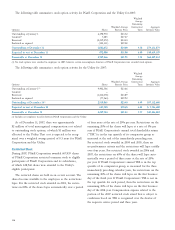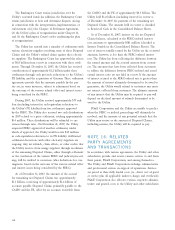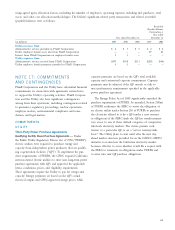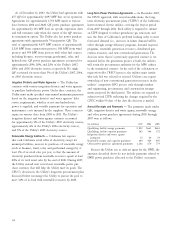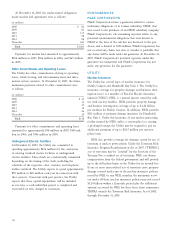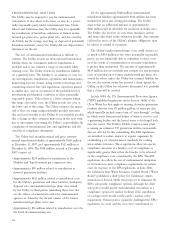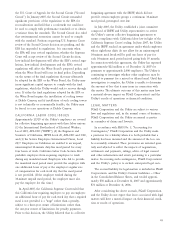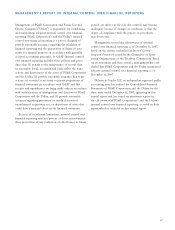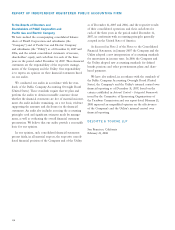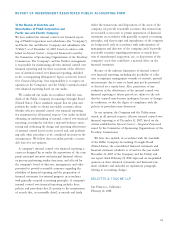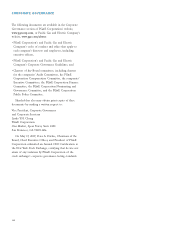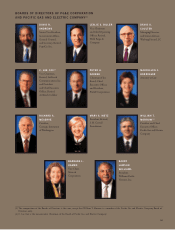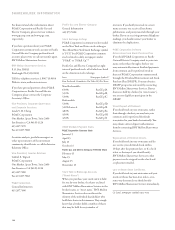PG&E 2007 Annual Report Download - page 137
Download and view the complete annual report
Please find page 137 of the 2007 PG&E annual report below. You can navigate through the pages in the report by either clicking on the pages listed below, or by using the keyword search tool below to find specific information within the annual report.135
the U.S. Court of Appeals for the Second Circuit (“Second
Circuit”). In January 2007, the Second Circuit remanded
signifi cant provisions of the regulations to the EPA for
reconsideration and held that a cost-benefi t test could not
be used to comply with performance standards or to obtain
a variance from the standards. The Second Circuit also ruled
that environmental restoration cannot be used to comply
with the standard. Petitions requesting U.S. Supreme Court
review of the Second Circuit decision are pending, and the
EPA has suspended its regulations. It is uncertain when
the EPA will issue revised regulations, whether the Supreme
Court will accept review of the Second Circuit decision,
how judicial developments will affect the EPA’s revised regu-
lations, how judicial developments and the EPA’s revised
regulations will affect the Water Board’s proposed policy, and
when the Water Board will issue its fi nal policy. Depending
on the nature of the fi nal regulations that may ultimately
be adopted by the EPA or the Water Board, the Utility may
incur signifi cant capital expense to comply with the fi nal
regulations, which the Utility would seek to recover through
rates. If either the fi nal regulations adopted by the EPA or
the Water Board require the installation of cooling towers
at Diablo Canyon, and if installation of such cooling towers
is not technically or economically feasible, the Utility may
be forced to cease operations at Diablo Canyon.
CALIFORNIA LABOR CODE ISSUES
Approximately 12,929 of the Utility’s employees are covered
by collective bargaining agreements with three labor unions:
(1) the International Brotherhood of Electrical Workers,
Local 1245, AFL-CIO (“IBEW”); (2) the Engineers and
Scientists of California, IFPTE Local 20, AFL-CIO and CLC,
and (3) the Service Employees International Union, Local
24/7. Employees in California are entitled to an unpaid,
uninterrupted 30-minute duty-free meal period for every
four hours of work. California Labor Code Section 226.7
prohibits employers from requiring employees to work
during any mandated meal. Employers who fail to provide
the mandated meal period must provide the employee with
one additional hour of pay at the employee’s regular rate
of compensation for each work day that the meal period
is not provided. (If the employee worked during the
30-minute unpaid meal period, the employer must also
pay the employee for this time.)
In April 2007, the California Supreme Court ruled that
this California law requiring employers to pay an employee
an additional hour of pay for each work day that a required
meal is not provided is a “wage” rather than a penalty,
subject to a three-year statute of limitations rather than
the one-year statute of limitations for penalty payments.
Prior to this decision, the Utility believed that its collective
bargaining agreement with the IBEW, which did not
provide certain employee groups a continuous 30-minute
meal period, preempted state law.
In July 2007, the Utility established a joint committee
composed of IBEW and Utility representatives to review
the Utility’s current collective bargaining agreements to
ensure compliance with California labor law in light of the
California Supreme Court’s ruling. In June 2007, the Utility
and the IBEW reached an agreement under which employees
whose eight-hour shifts do not allow for an uninterrupted
30-minute meal break will be paid one hour of pay for
each 30-minute meal period missed going back 39 months.
In connection with this agreement, the Utility has expensed
approximately $22 million as of December 31, 2007 for
payments to approximately 2,000 employees. The Utility is
continuing to investigate whether other employees may be
entitled to payment for a missed or delayed meal. Until this
investigation is complete, the Utility is unable to determine
the amount of loss that it may incur in connection with
this matter. The ultimate outcome of this matter may have
a material adverse impact on PG&E Corporation’s and the
Utility’s results of operations or fi nancial condition.
LEGAL MATTERS
PG&E Corporation and the Utility are subject to various
laws and regulations and, in the normal course of business,
PG&E Corporation and the Utility are named as parties
in a number of claims and lawsuits.
In accordance with SFAS No. 5, “Accounting for
Contingencies,” PG&E Corporation and the Utility make
a provision for a liability when it is both probable that a
liability has been incurred and the amount of the loss can
be reasonably estimated. These provisions are reviewed quar-
terly and adjusted to refl ect the impacts of negotiations,
settlements and payments, rulings, advice of legal counsel
and other information and events pertaining to a particular
matter. In assessing such contingencies, PG&E Corporation’s
and the Utility’s policy is to exclude anticipated legal costs.
The accrued liability for legal matters is included in PG&E
Corporation’s and the Utility’s Current Liabilities — Other
in the Consolidated Balance Sheets, and totaled approxi-
mately $78 million at December 31, 2007 and approximately
$74 million at December 31, 2006.
After considering the above accruals, PG&E Corporation
and the Utility do not expect that losses associated with legal
matters will have a material impact on their fi nancial condi-
tion or results of operations.



